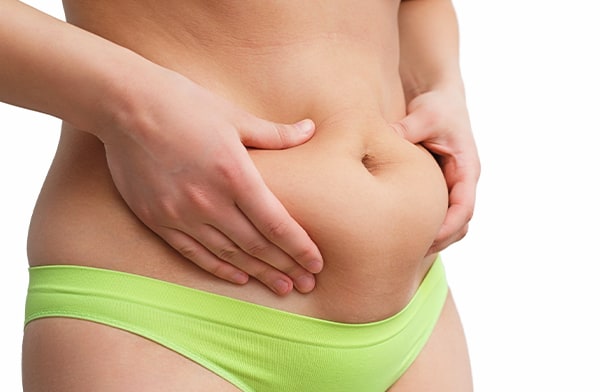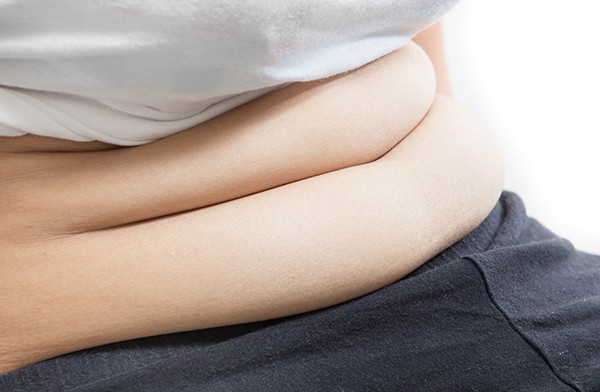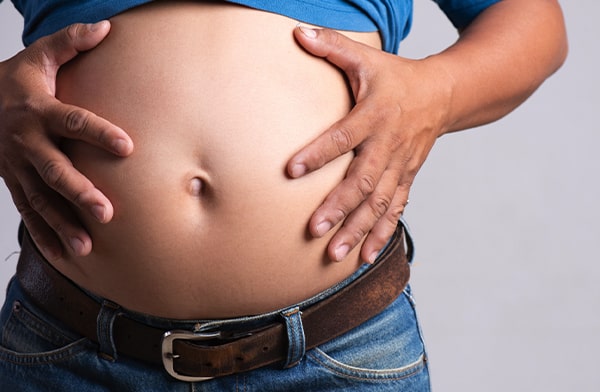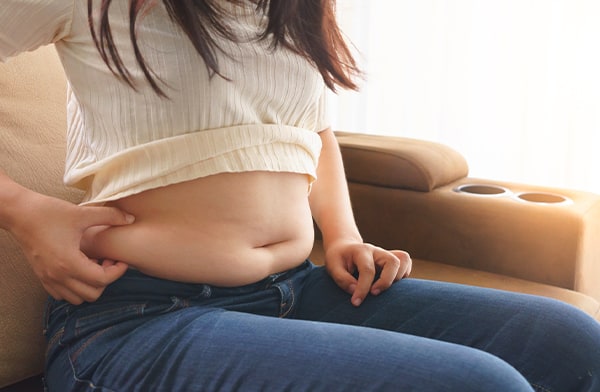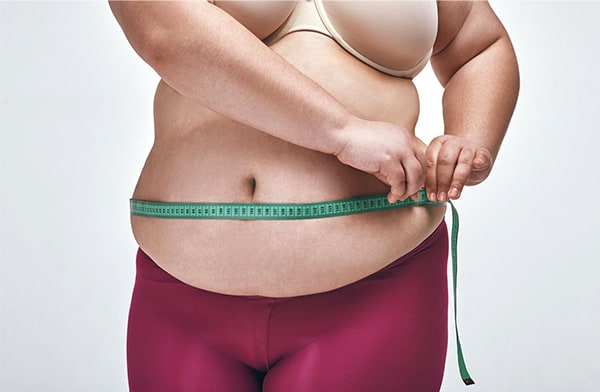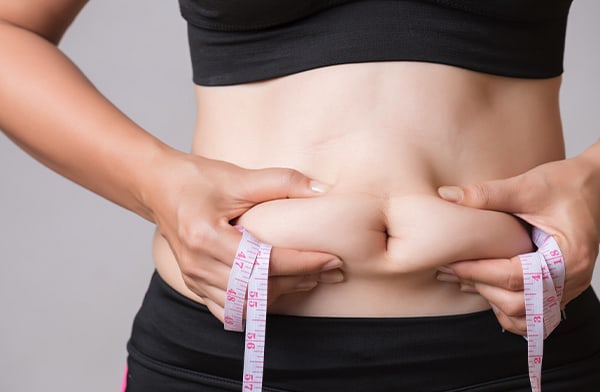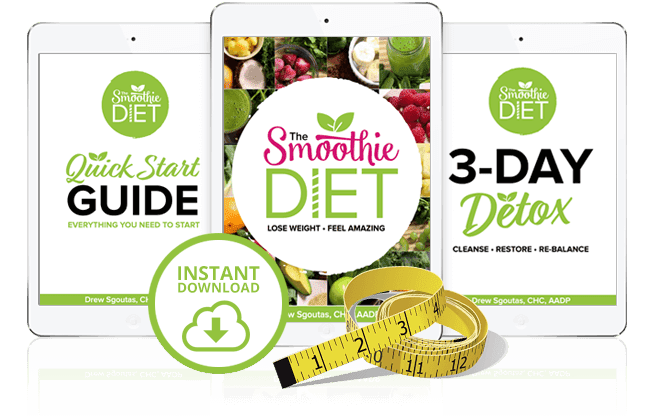There Are 6 Belly Shapes: Which Belly Type Do You Have?
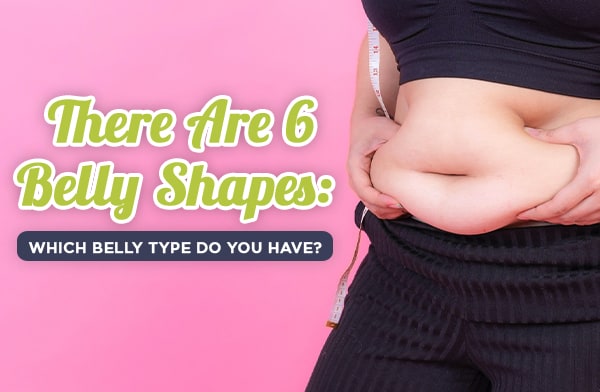
It’s no secret that different people carry weight differently. Some accumulate it in their bellies, while others spread it all over their body. Two different people at the same height and weight can look very different, even discounting other physical differences.
There are, roughly speaking, six types of belly. These six different body shapes look different and can be handled in different ways, though all of them share some of the same attributes. More importantly, they have different causes, which means you need different changes in your life to handle them. So what are they, and what can you do with them?
1: Stress Belly
Stress belly is, as you might imagine, a belly type that comes from being stressed out on the regular. This is because stress releases a hormone in your body called cortisol. Cortisol has a lot of effects on the body, but one of them comes from our days as hunter-gatherers. Back millennia ago, humans had to fend for themselves in the wilderness. If food was scarce, you had to struggle to survive. Starvation was a regular occurrence.
Stress, such as fighting off a predator or chasing prey, triggered hormones to boost bodily function and prepare for the bounty that may result from the stress. Among other things, that hormone encourages your body to store excess energy as fat.
The idea is that in times of famine, your body can then use that stored energy. And, in times of wealth, lower stress levels allow the body to not keep that fat around because it doesn’t need it.
Unfortunately, in our society, we have a lot of sources of stress that aren’t related to physical activity. Whether it’s chronic stress from work, the mental and physical effort of our daily lives, or just stressful events happening in rapid succession, there are a ton of stressors we face daily that we never would have before the invention of things like computers, commerce, or agriculture.
Obviously, the way you deal with stress belly is by reducing stress in your life. Try to drink plenty of water, get enough sleep every night at a consistent time, and try to reduce stress in other areas of your life. You can also work on eating healthier, including eating more antioxidants to combat oxidative stress in your body. Inflammation also adds chronic stress to your body, so anti-inflammatories can go a long way towards helping as well.
2: Tiered Belly
A tiered belly is characterized by two “layers” of fat. Generally, you can sort of feel them being vaguely separate around the belly button. This indicates multiple sources of fat storage, both resulting in the same kind of weight.
Tiered belly comes from many different sources, but it usually all comes back to the same sources we think about for weight gain: calories. Too many calories, too much junk, and not enough healthy nutrients can result in this kind of fat.
Unlike stress belly, this one isn’t nearly as easy to handle. Generally, you will need to embark on a quest of cutting out calories, exercising and working out, and balancing out your nutrients. Macronutrients are the most important part to address here.
You can only do so much with diet alone. Something like The Smoothie Diet can help a lot, but you still have a hard limit on the amount of weight you can lose per week without starving yourself into famine mode or, worse, hospitalization.
Exercise is your best plan for this kind of belly. You want to burn as many calories as you can safely, while providing replacement calories in the form of protein. The more muscle you build, the more fuel it takes to keep it going, and the more calories you’ll burn with that muscle. Plus, you’re never at risk of “accidentally” getting too bulky. Bodybuilders spend thousands of hours to get where they are; you can’t do that without extremely concerted efforts. All the exercise you need to lose weight will only help you lose weight, not get swole.
3: Bloating Belly
This kind of belly comes and goes, not throughout the months but throughout the days. Bloating can dramatically affect your appearance on a daily basis. On top of that, it often feels uncomfortable or even painful, with pressure and aches throughout your abdomen. For people who don’t regularly experience it, bloating can be concerning.
Bloating is most often caused by a build-up of gas, and as such, the “belly” you get from it isn’t actually fat. The belly is, instead, your existing flesh simply being pushed further out as your organs fill with air. Eventually, your body either absorbs the air and breaks it down or passes it out through one end or the other of your digestive system.
There are a few different ways you can handle this kind of belly. The first is to work on passing the air, which usually requires careful pressing on your abdomen, taking exotic yoga positions like downward dog, and time. Of course, this isn’t very convenient, fast, easy, or effective.
The best option is to work on your diet. Bloating is most commonly due to a dietary issue, usually eating too much sugar and processed ingredients. It may also relate to something you have a dietary sensitivity to, like dairy. Many people who are lactose intolerant find that bloating is one of their primary symptoms.
You should adjust your diet with three goals in mind. The first goal is to eliminate the ingredients causing bloating, like sugar or lactose. The second is to eat more ingredients that inhibit bloating, like fiber and protein. The third is to eat more probiotics. Probiotics out-compete the harmful bacteria that give off gas as part of their life cycle. Overall, these changes can help eliminate bloating.
One thing to be aware of is if you’re feeling sharp pains or bloating that doesn’t go away after days or anti-gas medication. In extreme cases, you can end up with a perforated bowel, which is a serious medical condition.
4: Hormonal Belly
Hormonal belly is more of a side weight form of belly fat rather than a front weight. You might also recognize it as love handles. Often, hormonal belly can also be coupled with fat stored throughout the body, especially in places it might not otherwise reside.
As the name implies, hormonal belly comes from hormonal imbalances. Sometimes this can be related to diet if you’re deficient in a nutrient that is necessary to form the precursors for the hormones and neurotransmitters you need. More often, it’s a sign of something wrong with your hormonal system. This can range anywhere from hypo or hyperthyroidism, to PCOS, to any of the many potential benign or worse tumors that can affect the various glands throughout your system.
This kind of weight is often resistant to simply dieting and even some exercise. It will also affect you in other ways by suppressing energy levels, potentially hampering your moods, and causing other cognitive problems.
The best way to handle this is usually with medication. You’ll want to talk to your doctor about what possible issues you’re having and perform tests to see if you have a specific cause. Sometimes, medication can solve the issue. Other times, you might need something stronger, or even surgical procedures to remove a cyst or tumor pressing on a gland.
5: Muffin Top Belly
The muffin top is one of the most common forms of belly fat and generally comes from overall body weight. Much like the tiered belly, you need to work on diet and exercise for this one. Generally, it presents as fat that sits higher on your torso and “spills over” your waistband when you wear tighter pants. Hence the name, you know, looking like a muffin.
One of the biggest causes of this kind of fat is carbs. Eating too many carbs can result in a ton of stored fat because it’s the easiest form of energy for the body to break down and store. You’ll need to adjust your diet to cut down on carbs and sugars, which can be quite difficult. Luckily, there are a lot of diets out there that can help.
This can be one of the more implacable kinds of belly to deal with because it’s slow to respond. Most efforts at dieting and exercise will take fat off in generally equal portions from around the body, which means you’ll see progress, but only very slowly. Unfortunately, targeting weight loss isn’t possible, so you can’t just do more crunches or sit-ups and get rid of it.
6: Pregnant/Postpartum Belly
Another kind of belly is the pregnancy belly. Obviously only affecting women, your body builds up fat as both protection and nutrition for the developing child. It helps form a barrier so that if you, for example, bump into something with your pregnant belly, you don’t damage the fetus inside.
This kind of belly, unfortunately, doesn’t go away at birth. The child exits your body, sure, but a lot of the fat present in your stomach stays there. Once you’re no longer pregnant, your body can work on getting rid of that fat.
Many mothers experience a lingering of this fat, as well as other problems like incontinence, after giving birth. If this sticks around, talk to your doctor. You might have something called diastasis recti, which is a medical condition characterized by a separation of your abdominal muscles. It’s very common, but it does require physical therapy and self-care attention to treat.
Other Bellies
These are the six main forms of belly you might have, but there are others that may have different triggers, similar appearances, or just different names. These include:
- Alcohol belly. This belly comes when you drink a lot of alcohol, which is high in carbs. It’s similar to muffin top, and despite the name, isn’t always just a “beer belly” as much as it is general alcohol. You’ll want to cut back on the alcohol and work on eating more healthy fats.
- Punctured Tire belly. This is a flabby, distended kind of belly that accumulates largely around the abdomen. It’s mostly caused by a lack of exercise while still eating a poor diet, and sags like a flat tire. It’s largely a matter of diet and exercise, but you’ll want to start things slowly; trying to do too much at once can put your body into starvation mode and make rebounding much more likely.
- Visceral Fat belly. Visceral fat is fat that fills up the space between organs in your belly. You’ll look and feel fat, but your skin may be firm because the fat is deeper inside. This is often caused by an issue processing sugar and can be indicative of diabetes. You’ll want to consult a doctor about this one.
- Water belly. Water retention is similar to bloating, except it’s caused by water more than air. Water weight is a significant part of your body, and it’s important to get enough hydration. The key to handling this one is generally cutting back on salt. You want to make sure you have enough electrolytes, but not too many. As usual, it comes back to a balanced diet.
You may also see some of the above belly types referred to by other names, like saddle belly, ovary belly, or liver belly.
All forms of belly can generally be boiled down to three issues: imbalances in hormones, poor diet, and lack of exercise. Solve the latter two, and see a doctor to address the first one, and you’ll be well on your way to getting rid of that unwanted belly.
The Smoothie Diet can help with the dieting part of the plan, but you’ll need to talk to a doctor and a personal trainer for the other two. Smoothies alone can’t solve belly fat; they can just help you get on the right track with adjusting your diet.
Have any questions regarding belly types, how to better handle your belly type, or the Smoothie Diet? Please feel free to leave a comment down below, and I’d be more than happy to help you out however I can!

